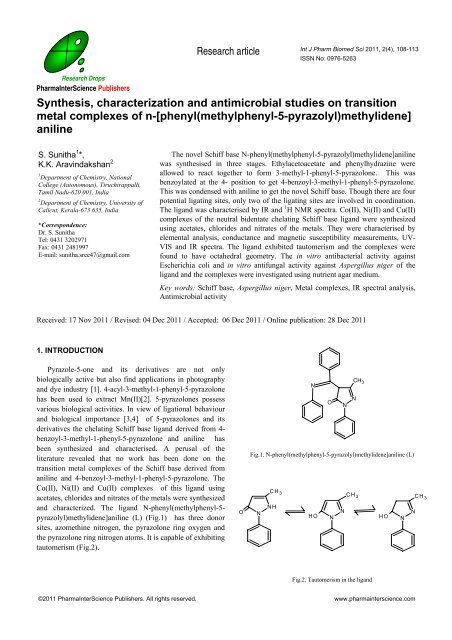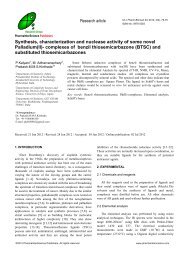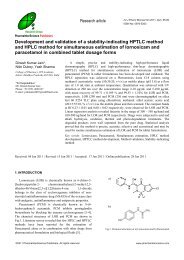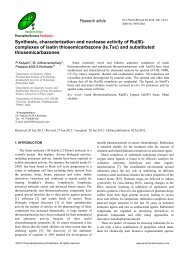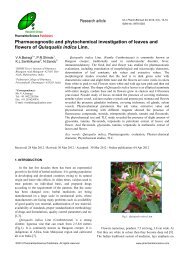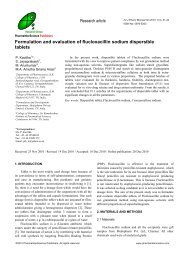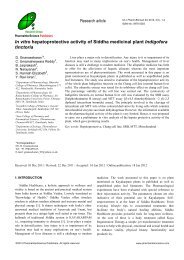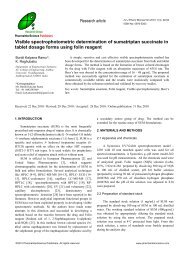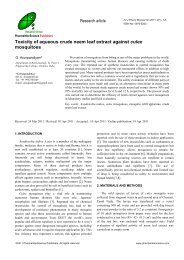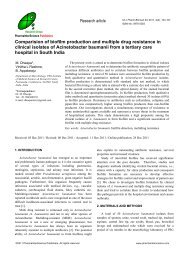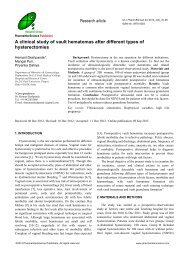Synthesis, characterization and antimicrobial studies on transition ...
Synthesis, characterization and antimicrobial studies on transition ...
Synthesis, characterization and antimicrobial studies on transition ...
You also want an ePaper? Increase the reach of your titles
YUMPU automatically turns print PDFs into web optimized ePapers that Google loves.
Research article<br />
Int J Pharm Biomed Sci 2011, 2(4), 108-113<br />
ISSN No: 0976-5263<br />
Research Drops<br />
PharmaInterScience Publishers<br />
<str<strong>on</strong>g>Synthesis</str<strong>on</strong>g>, <str<strong>on</strong>g>characterizati<strong>on</strong></str<strong>on</strong>g> <str<strong>on</strong>g>and</str<strong>on</strong>g> <str<strong>on</strong>g>antimicrobial</str<strong>on</strong>g> <str<strong>on</strong>g>studies</str<strong>on</strong>g> <strong>on</strong> transiti<strong>on</strong><br />
metal complexes of n-[phenyl(methylphenyl-5-pyrazolyl)methylidene]<br />
aniline<br />
S. Sunitha 1 *,<br />
K.K. Aravindakshan 2<br />
1 Department of Chemistry, Nati<strong>on</strong>al<br />
College (Aut<strong>on</strong>omous), Tiruchirappalli,<br />
Tamil Nadu-620 001, India<br />
2 Department of Chemistry, University of<br />
Calicut, Kerala-673 635, India<br />
*Corresp<strong>on</strong>dence:<br />
Dr. S. Sunitha<br />
Tel: 0431 3202971<br />
Fax: 0431 2481997<br />
E-mail: sunitha.sree47@gmail.com<br />
The novel Schiff base N-phenyl(methylphenyl-5-pyrazolyl)methylidene]aniline<br />
was synthesised in three stages. Ethylacetoacetate <str<strong>on</strong>g>and</str<strong>on</strong>g> phenylhydrazine were<br />
allowed to react together to form 3-methyl-1-phenyl-5-pyrazol<strong>on</strong>e. This was<br />
benzoylated at the 4- positi<strong>on</strong> to get 4-benzoyl-3-methyl-1-phenyl-5-pyrazol<strong>on</strong>e.<br />
This was c<strong>on</strong>densed with aniline to get the novel Schiff base. Though there are four<br />
potential ligating sites, <strong>on</strong>ly two of the ligating sites are involved in coordinati<strong>on</strong>.<br />
The lig<str<strong>on</strong>g>and</str<strong>on</strong>g> was characterised by IR <str<strong>on</strong>g>and</str<strong>on</strong>g> 1 H NMR spectra. Co(II), Ni(II) <str<strong>on</strong>g>and</str<strong>on</strong>g> Cu(II)<br />
complexes of the neutral bidentate chelating Schiff base lig<str<strong>on</strong>g>and</str<strong>on</strong>g> were synthesized<br />
using acetates, chlorides <str<strong>on</strong>g>and</str<strong>on</strong>g> nitrates of the metals. They were characterised by<br />
elemental analysis, c<strong>on</strong>ductance <str<strong>on</strong>g>and</str<strong>on</strong>g> magnetic susceptibility measurements, UV-<br />
VIS <str<strong>on</strong>g>and</str<strong>on</strong>g> IR spectra. The lig<str<strong>on</strong>g>and</str<strong>on</strong>g> exhibited tautomerism <str<strong>on</strong>g>and</str<strong>on</strong>g> the complexes were<br />
found to have octahedral geometry. The in vitro antibacterial activity against<br />
Escherichia coli <str<strong>on</strong>g>and</str<strong>on</strong>g> in vitro antifungal activity against Aspergillus niger of the<br />
lig<str<strong>on</strong>g>and</str<strong>on</strong>g> <str<strong>on</strong>g>and</str<strong>on</strong>g> the complexes were investigated using nutrient agar medium.<br />
Key words: Schiff base, Aspergillus niger, Metal complexes, IR spectral analysis,<br />
Antimicrobial activity<br />
Received: 17 Nov 2011 / Revised: 04 Dec 2011 / Accepted: 06 Dec 2011 / Online publicati<strong>on</strong>: 28 Dec 2011<br />
1. INTRODUCTION<br />
Pyrazole-5-<strong>on</strong>e <str<strong>on</strong>g>and</str<strong>on</strong>g> its derivatives are not <strong>on</strong>ly<br />
biologically active but also find applicati<strong>on</strong>s in photography<br />
<str<strong>on</strong>g>and</str<strong>on</strong>g> dye industry [1]. 4-acyl-3-methyl-1-phenyl-5-pyrazol<strong>on</strong>e<br />
has been used to extract Mn(II)[2]. 5-pyrazol<strong>on</strong>es possess<br />
various biological activities. In view of ligati<strong>on</strong>al behaviour<br />
<str<strong>on</strong>g>and</str<strong>on</strong>g> biological importance [3,4] of 5-pyrazol<strong>on</strong>es <str<strong>on</strong>g>and</str<strong>on</strong>g> its<br />
derivatives the chelating Schiff base lig<str<strong>on</strong>g>and</str<strong>on</strong>g> derived from 4-<br />
benzoyl-3-methyl-1-phenyl-5-pyrazol<strong>on</strong>e <str<strong>on</strong>g>and</str<strong>on</strong>g> aniline has<br />
been synthesized <str<strong>on</strong>g>and</str<strong>on</strong>g> characterised. A perusal of the<br />
literature revealed that no work has been d<strong>on</strong>e <strong>on</strong> the<br />
transiti<strong>on</strong> metal complexes of the Schiff base derived from<br />
aniline <str<strong>on</strong>g>and</str<strong>on</strong>g> 4-benzoyl-3-methyl-1-phenyl-5-pyrazol<strong>on</strong>e. The<br />
Co(II), Ni(II) <str<strong>on</strong>g>and</str<strong>on</strong>g> Cu(II) complexes of this lig<str<strong>on</strong>g>and</str<strong>on</strong>g> using<br />
acetates, chlorides <str<strong>on</strong>g>and</str<strong>on</strong>g> nitrates of the metals were synthesized<br />
<str<strong>on</strong>g>and</str<strong>on</strong>g> characterized. The lig<str<strong>on</strong>g>and</str<strong>on</strong>g> N-phenyl(methylphenyl-5-<br />
pyrazolyl)methylidene]aniline (L) (Fig.1) has three d<strong>on</strong>or<br />
sites, azomethine nitrogen, the pyrazol<strong>on</strong>e ring oxygen <str<strong>on</strong>g>and</str<strong>on</strong>g><br />
the pyrazol<strong>on</strong>e ring nitrogen atoms. It is capable of exhibiting<br />
tautomerism (Fig.2).<br />
O<br />
CH 3<br />
N<br />
N<br />
O<br />
N<br />
Fig.1. N-phenyl(methylphenyl-5-pyrazolyl)methylidene]aniline (L)<br />
CH 3<br />
CH 3<br />
CH 3<br />
NH<br />
N<br />
N<br />
N<br />
HO N<br />
H O N<br />
Fig.2. Tautomerism in the lig<str<strong>on</strong>g>and</str<strong>on</strong>g><br />
©2011 PharmaInterScience Publishers. All rights reserved. www.pharmainterscience.com
S. Sunitha <str<strong>on</strong>g>and</str<strong>on</strong>g> K.K. Aravindakshan, Int J Pharm Biomed Sci 2011, 2(4), 103-113<br />
109<br />
2. MATERIALS AND METHODS<br />
All chemicals used in the present work viz.,aniline,<br />
benzoylchloride, ethylacetoacetate, phenylhydrazine,<br />
is<strong>on</strong>iazid, metal salts, solvents etc., were of AR grade. (BDH,<br />
Sarabhai, Qualigens, E. Merck, Loba Chemie or Glaxo).<br />
Carb<strong>on</strong>, hydrogen <str<strong>on</strong>g>and</str<strong>on</strong>g> nitrogen analyses were carried out<br />
by using VarioEL III CHNS analyser at SAIF, CUSAT,<br />
Kochi. The ani<strong>on</strong>s present in the complexes were estimated<br />
by st<str<strong>on</strong>g>and</str<strong>on</strong>g>ard methods. The 1 H NMR spectrum of the lig<str<strong>on</strong>g>and</str<strong>on</strong>g><br />
was recorded <strong>on</strong> Advance III 500 MHz Bruker spectrometer<br />
using DMSO-d 6 as solvent. Infrared spectra were measured in<br />
the range 4000-400 cm -1 as KBr pellets <strong>on</strong> a Perkin-Elmer<br />
spectrophotometer. The solid-state electr<strong>on</strong>ic spectra of the<br />
complexes were recorded <strong>on</strong> a JASCO UV-Visible<br />
spectrophotometer. The magnetic measurements were made<br />
at room temperature by Evans method using Hg[Co(CNS) 4 ]<br />
as calibrant.<br />
2.1 <str<strong>on</strong>g>Synthesis</str<strong>on</strong>g> of the compounds<br />
The synthesis of the lig<str<strong>on</strong>g>and</str<strong>on</strong>g> c<strong>on</strong>sisted of three stages. The<br />
first stage which involves the preparati<strong>on</strong> of 3-methyl-1-<br />
phenyl-5-pyrazol<strong>on</strong>e[5] <str<strong>on</strong>g>and</str<strong>on</strong>g> the sec<strong>on</strong>d stage which involves<br />
the benzoylati<strong>on</strong> of the above to 4-benzoyl-3-methyl-1-<br />
phenyl-5-pyrazol<strong>on</strong>e were carried out using Jensen’s<br />
procedure [6]. The third stage involved the c<strong>on</strong>densati<strong>on</strong> of<br />
4-benzoyl-3-methyl-1-phenyl-5-pyrazol<strong>on</strong>e with distilled<br />
aniline to prepare the Schiff base lig<str<strong>on</strong>g>and</str<strong>on</strong>g>. Added an ethanolic<br />
soluti<strong>on</strong> of aniline (0.0109 mol, 1mL) to a hot refluxing<br />
soluti<strong>on</strong> of 4-benzoyl-3-methyl-1-phenyl-5-pyrazol<strong>on</strong>e(0.01<br />
mol, 2.7840 g) in ethanol <str<strong>on</strong>g>and</str<strong>on</strong>g> refluxed for 3 h .The lem<strong>on</strong><br />
yellow coloured crystals obtained <strong>on</strong> cooling were filtered at<br />
the pump, washed with ethanol <str<strong>on</strong>g>and</str<strong>on</strong>g> dried (yield= 65.8%).<br />
Complexes of Co(II) with this lig<str<strong>on</strong>g>and</str<strong>on</strong>g> were synthesized<br />
using iodide <str<strong>on</strong>g>and</str<strong>on</strong>g> nitrate salts of the metal. Complexes of<br />
Ni(II) with this lig<str<strong>on</strong>g>and</str<strong>on</strong>g> were synthesized using acetate salt of<br />
the metal. Complexes of Cu(II) of this lig<str<strong>on</strong>g>and</str<strong>on</strong>g> were<br />
synthesized using acetate, chloride, nitrate <str<strong>on</strong>g>and</str<strong>on</strong>g> sulphate salts<br />
of the metal. Soluti<strong>on</strong>s of the lig<str<strong>on</strong>g>and</str<strong>on</strong>g> <str<strong>on</strong>g>and</str<strong>on</strong>g> iodide <str<strong>on</strong>g>and</str<strong>on</strong>g> nitrate<br />
salts of Co(II) salts in methanol (2:1 molar ratio) were<br />
refluxed for 0.5h. Acetate of Ni(II)salt, nitrate <str<strong>on</strong>g>and</str<strong>on</strong>g> sulphate<br />
salts of Cu(II) were dissolved in water <str<strong>on</strong>g>and</str<strong>on</strong>g> added to the<br />
refluxing soluti<strong>on</strong> of the lig<str<strong>on</strong>g>and</str<strong>on</strong>g> in methanol (1:2 molar ratio)<br />
<str<strong>on</strong>g>and</str<strong>on</strong>g> refluxed for 2h. Acetate of Cu(II) was dissolved in<br />
ethanol <str<strong>on</strong>g>and</str<strong>on</strong>g> added to a refluxing soluti<strong>on</strong> of methanol(1:2<br />
molar ratio) <str<strong>on</strong>g>and</str<strong>on</strong>g> refluxed for 15 min. The chloride of Cu(II)<br />
was dissolved in methanol <str<strong>on</strong>g>and</str<strong>on</strong>g> added to refluxing soluti<strong>on</strong> of<br />
the lig<str<strong>on</strong>g>and</str<strong>on</strong>g> in methanol (1:2 molar ratio) <str<strong>on</strong>g>and</str<strong>on</strong>g> refluxed for 7.5h.<br />
The complexes formed <strong>on</strong> cooling were filtered off, washed<br />
with the respective solvents <str<strong>on</strong>g>and</str<strong>on</strong>g> dried except the complex<br />
synthesized using the chloride of Cu(II) in which case the<br />
volume was reduced to half by evaporating off the solvent.<br />
The solid which separated was filtered off, washed with the<br />
solvent <str<strong>on</strong>g>and</str<strong>on</strong>g> dried.<br />
3. RESULTS AND DISCUSSION<br />
3.1 Characterizati<strong>on</strong> of the lig<str<strong>on</strong>g>and</str<strong>on</strong>g><br />
The lig<str<strong>on</strong>g>and</str<strong>on</strong>g> was characterized by m.p., elemental<br />
analysis, 1 H NMR <str<strong>on</strong>g>and</str<strong>on</strong>g> IR spectral data. The 1 H NMR<br />
spectrum of the lig<str<strong>on</strong>g>and</str<strong>on</strong>g> was recorded in DMSO-d 6 <str<strong>on</strong>g>and</str<strong>on</strong>g> it<br />
showed a number of characteristic signals of the compound<br />
[7,8]. The singlet observed at 1.4 ∂ was assigned to the<br />
methyl group at 3 positi<strong>on</strong> of the pyrazol<strong>on</strong>e ring. The<br />
multiplet observed in the range 7.0-7.5 ∂ was assigned to the<br />
aromatic prot<strong>on</strong>s. The singlet at 8.0 ∂ was assigned to the<br />
prot<strong>on</strong> at 4 positi<strong>on</strong> of the pyrazol<strong>on</strong>e ring. Singlets at 2.4 ∂<br />
<str<strong>on</strong>g>and</str<strong>on</strong>g> 3.4 ∂ are due to DMSO-d 6 <str<strong>on</strong>g>and</str<strong>on</strong>g> H 2 O. The IR spectrum of<br />
the lig<str<strong>on</strong>g>and</str<strong>on</strong>g> showed a number of absorpti<strong>on</strong> b<str<strong>on</strong>g>and</str<strong>on</strong>g>s which were<br />
characteristic of the different groups present in it [7,8]. The<br />
b<str<strong>on</strong>g>and</str<strong>on</strong>g>s present at 1628 cm -1 <str<strong>on</strong>g>and</str<strong>on</strong>g> at 1226 cm -1 have been<br />
assigned to >C=N <str<strong>on</strong>g>and</str<strong>on</strong>g> C-N stretching vibrati<strong>on</strong>s,<br />
respectively. The characteristic frequency due to the<br />
stretching of the aromatic keto group, at 1650 cm -1 was not<br />
present in the spectrum, which indicated that c<strong>on</strong>densati<strong>on</strong><br />
between 4-benzoyl-3-methyl-1-phenyl-5-pyrazol<strong>on</strong>e <str<strong>on</strong>g>and</str<strong>on</strong>g><br />
aniline was complete. The b<str<strong>on</strong>g>and</str<strong>on</strong>g> at 1500 cm -1 has been<br />
assigned to >C=O group of the pyrazol<strong>on</strong>e ring. The b<str<strong>on</strong>g>and</str<strong>on</strong>g>s<br />
due to the in plane bending of the aromatic C-H stretching<br />
are usually found in the range 1250-950 cm -1 . The b<str<strong>on</strong>g>and</str<strong>on</strong>g>s at<br />
1138 cm -1 , 1007 cm -1 <str<strong>on</strong>g>and</str<strong>on</strong>g> 906 cm -1 have been assigned to<br />
these modes of vibrati<strong>on</strong>s. The most characteristic<br />
frequencies of aromatic groups were found below 900 cm -1 ,<br />
usually in the range 600-900cm -1 , due to the out-of-plane<br />
bending vibrati<strong>on</strong> of the aromatic C-H. The b<str<strong>on</strong>g>and</str<strong>on</strong>g>s at 770cm -1 ,<br />
760 cm -1 <str<strong>on</strong>g>and</str<strong>on</strong>g> 698 cm -1 have been assigned to these modes of<br />
vibrati<strong>on</strong>s. The elemental analysis <str<strong>on</strong>g>and</str<strong>on</strong>g> spectral data for L are<br />
c<strong>on</strong>sistent with the formula C 23 H 19 N 3 O.<br />
3.2 Formulae <str<strong>on</strong>g>and</str<strong>on</strong>g> general properties of complexes<br />
The reacti<strong>on</strong> of the lig<str<strong>on</strong>g>and</str<strong>on</strong>g> (L) with different salts of<br />
Co(II), Ni(II) <str<strong>on</strong>g>and</str<strong>on</strong>g> Cu(II) i<strong>on</strong>s in 2:1 molar ratios gave metal<br />
complexes of the given formulae, as evidenced by the microanalytical<br />
<str<strong>on</strong>g>and</str<strong>on</strong>g> spectral data.<br />
1. [ML 2 X 2 ]where M=Co(II), Ni(II) or Cu(II) <str<strong>on</strong>g>and</str<strong>on</strong>g><br />
X=CH 3 COO - , I - or NO 3<br />
-<br />
2. [Cu(L) 2 SO 4 ]<br />
Suggested structure for [ML 2 X 2 ] <str<strong>on</strong>g>and</str<strong>on</strong>g> [Cu(L) 2 SO 4 ] are<br />
shown in Fig.3 <str<strong>on</strong>g>and</str<strong>on</strong>g> Fig.4, respectively. The colours, magnetic<br />
susceptibilities, molar c<strong>on</strong>ductivities <str<strong>on</strong>g>and</str<strong>on</strong>g> melting points <str<strong>on</strong>g>and</str<strong>on</strong>g><br />
the micro-analytical data of the complexes are listed in<br />
Table 1. These air-stable metal complexes were n<strong>on</strong>hygroscopic,<br />
partially soluble in most of the organic solvents<br />
but freely soluble in DMF <str<strong>on</strong>g>and</str<strong>on</strong>g> DMSO. The molar<br />
c<strong>on</strong>ductivities in DMF/DMSO (10 -3 M) showed that all the<br />
complexes behaved as n<strong>on</strong>-electrolytes, indicating the<br />
coordinated nature of the ani<strong>on</strong>s.<br />
©2011 PharmaInterScience Publishers. All rights reserved. www.pharmainterscience.com
S. Sunitha <str<strong>on</strong>g>and</str<strong>on</strong>g> K.K. Aravindakshan, Int J Pharm Biomed Sci 2011, 2(4), 103-113<br />
110<br />
Table 1<br />
Formulae, general properties <str<strong>on</strong>g>and</str<strong>on</strong>g> micro analytical data of lig<str<strong>on</strong>g>and</str<strong>on</strong>g> <str<strong>on</strong>g>and</str<strong>on</strong>g> complexes<br />
Sl. No. Compound Colour Yield % MP (°C) µ eff (B.M.) Ω m<br />
Microanalytical data found (calculated) %<br />
(ohm -1 cm 2 mol -1 ) Metal C H N Ani<strong>on</strong><br />
1 C23H19N3O(L) Lem<strong>on</strong> yellow 66 162 - 77.01<br />
(78.19)<br />
2 [Co(L) 2 I 2 ] Brown 42 >300 4.84 10.75 5.65 55.26<br />
(5.78) (54.17)<br />
3 [Co(L) 2 (NO 3 ) 2 ] Brown 42 >300 3.10 0.0 6.60 64.09<br />
(6.63) (62.10)<br />
4 [Ni(L) 2 (CH 3 COO) 2 ] Pale green 40 >300 3.14 10.75 6.60 66.74<br />
(6.65) (67.97)<br />
5 [Ni(L) 2 (CH 3 COO) 2 ] Black 53 >300 1.96 0 7.10 68.14<br />
(7.16) (67.60)<br />
6 [Cu(L) 2 Cl 2 ] Green 52 >300 2.02 30.23 7.49 66.74<br />
(7.56) (65.67)<br />
7 [Cu(L) 2 (NO 3 ) 2 ] Green 51 >300 2.27 0.0 7.05 62.12<br />
(7.11) (61.78)<br />
8 [Cu(L) 2 SO 4 ] Green 50 >300 1.51 10.75 7.29 65.16<br />
(7.34) (63.77)<br />
5.25<br />
(5.38)<br />
3.70<br />
(3.73)<br />
4.25<br />
(4.27)<br />
4.30<br />
(4.98)<br />
4.98<br />
(4.96)<br />
4.99<br />
(4.52)<br />
4.20<br />
(4.25)<br />
5.11<br />
(4.39)<br />
11.80<br />
(11.89)<br />
8.21<br />
(8.24)<br />
14.38<br />
(14.40)<br />
9.95<br />
(9.52)<br />
9.48<br />
(9.46)<br />
10.25<br />
(9.99)<br />
12.57<br />
(12.53)<br />
10.07<br />
(9.70)<br />
-<br />
-<br />
-<br />
-<br />
-<br />
8.50<br />
(8.45)<br />
-<br />
-<br />
N<br />
C H 3<br />
N<br />
O<br />
N<br />
X<br />
M<br />
X<br />
N<br />
O<br />
N<br />
N<br />
CH 3<br />
Fig.3 Suggested structure for [ML 2 X 2 ], where M=Co(II), Ni(II) or Cu(II)<br />
<str<strong>on</strong>g>and</str<strong>on</strong>g> X=CH 3 COO - , I - or NO 3<br />
-<br />
C H 3<br />
N<br />
N<br />
O<br />
N<br />
O<br />
O<br />
S<br />
Cu<br />
O<br />
O<br />
O<br />
N<br />
N<br />
N<br />
CH 3<br />
1560-1531 cm -1 <str<strong>on</strong>g>and</str<strong>on</strong>g> were assigned to the coordinated<br />
azomethine groups present in them.<br />
In additi<strong>on</strong> to these, new b<str<strong>on</strong>g>and</str<strong>on</strong>g>s were present in the lower<br />
frequency regi<strong>on</strong> of the spectra of all these complexes. These<br />
b<str<strong>on</strong>g>and</str<strong>on</strong>g>s appeared in the range 665-650 <str<strong>on</strong>g>and</str<strong>on</strong>g> at 585 cm -1 in the<br />
spectra of the Co(II) complex, at 685 <str<strong>on</strong>g>and</str<strong>on</strong>g> 585 cm -1 in the<br />
spectrum of the Ni(II) complex <str<strong>on</strong>g>and</str<strong>on</strong>g> in the ranges 685-679<br />
<str<strong>on</strong>g>and</str<strong>on</strong>g> 607-580 cm -1 in the Cu(II) complexes. The first <strong>on</strong>e was<br />
assigned to the stretching vibrati<strong>on</strong>s of the M-N b<strong>on</strong>ds <str<strong>on</strong>g>and</str<strong>on</strong>g><br />
the sec<strong>on</strong>d <strong>on</strong>e to that of the M-O b<strong>on</strong>ds formed during<br />
complexati<strong>on</strong>. The M-O b<strong>on</strong>d is due to coordinated nitrate or<br />
acetate ani<strong>on</strong> or due to coordinated oxygen atom of the 5-<br />
pyrazol<strong>on</strong>e ring of the lig<str<strong>on</strong>g>and</str<strong>on</strong>g>.<br />
The absence of sharp b<str<strong>on</strong>g>and</str<strong>on</strong>g>s in the regi<strong>on</strong> 3441-3060 cm -1<br />
in the spectra of all the complexes <str<strong>on</strong>g>and</str<strong>on</strong>g> the lig<str<strong>on</strong>g>and</str<strong>on</strong>g> indicates<br />
that N-H group is not present in the lig<str<strong>on</strong>g>and</str<strong>on</strong>g> <str<strong>on</strong>g>and</str<strong>on</strong>g> in the<br />
complexes. The absence of a broad b<str<strong>on</strong>g>and</str<strong>on</strong>g> in this regi<strong>on</strong> is an<br />
indicati<strong>on</strong> of the absence of coordinated water as well.<br />
Elemental analyses also corresp<strong>on</strong>ded to the absence of<br />
coordinated water in the complexes.<br />
3.4 Coordinati<strong>on</strong> of ani<strong>on</strong>s<br />
Fig.4. Suggested structure for [Cu(L) 2 SO 4 ]<br />
3.3 IR spectra of complexes<br />
Table 2 lists the most important IR spectral b<str<strong>on</strong>g>and</str<strong>on</strong>g>s of the<br />
lig<str<strong>on</strong>g>and</str<strong>on</strong>g> <str<strong>on</strong>g>and</str<strong>on</strong>g> metal complexes. All the complexes showed<br />
downshift in the characteristic absorpti<strong>on</strong> frequency of the<br />
azomethine group thus indicating that the nitrogen atom of<br />
the azomethine group is coordinated to the metal. The b<str<strong>on</strong>g>and</str<strong>on</strong>g> at<br />
1628 cm -1 observed in the spectrum of the lig<str<strong>on</strong>g>and</str<strong>on</strong>g> was absent<br />
in all the complexes. Instead, b<str<strong>on</strong>g>and</str<strong>on</strong>g>s appeared in the ranges of<br />
Two str<strong>on</strong>g b<str<strong>on</strong>g>and</str<strong>on</strong>g>s at 1632 <str<strong>on</strong>g>and</str<strong>on</strong>g> 1376 cm -1 observed in the<br />
IR spectra of the acetato complex of Ni(II) <str<strong>on</strong>g>and</str<strong>on</strong>g> two str<strong>on</strong>g<br />
b<str<strong>on</strong>g>and</str<strong>on</strong>g>s at 1640 <str<strong>on</strong>g>and</str<strong>on</strong>g> 1360 cm -1 in the spectra of the acetato<br />
Cu(II) complex were assigned to υ(C=O) <str<strong>on</strong>g>and</str<strong>on</strong>g> υ(C—O),<br />
respectively. Since the separati<strong>on</strong> between the two υ(CO) is<br />
much larger than that in the free i<strong>on</strong>, we c<strong>on</strong>clude that the<br />
acetate i<strong>on</strong> coordinates to the nickel(II) i<strong>on</strong> <str<strong>on</strong>g>and</str<strong>on</strong>g> copper(II) in<br />
an unidentate fashi<strong>on</strong> [9].<br />
The absence of b<str<strong>on</strong>g>and</str<strong>on</strong>g>s at 2700-2500 cm -1 indicates that the<br />
complex is an O- isomer. This is also c<strong>on</strong>firmed by the<br />
presence of M-O b<strong>on</strong>d[10]. Microanalytical data <str<strong>on</strong>g>and</str<strong>on</strong>g> the n<strong>on</strong>c<strong>on</strong>ducting<br />
nature of these complexes supported this. A b<str<strong>on</strong>g>and</str<strong>on</strong>g><br />
of medium intensity was observed at 330 cm -1 in the spectra<br />
©2011 PharmaInterScience Publishers. All rights reserved. www.pharmainterscience.com
S. Sunitha <str<strong>on</strong>g>and</str<strong>on</strong>g> K.K. Aravindakshan, Int J Pharm Biomed Sci 2011, 2(4), 103-113<br />
111<br />
Table 2<br />
Significant IR spectral b<str<strong>on</strong>g>and</str<strong>on</strong>g>s of lig<str<strong>on</strong>g>and</str<strong>on</strong>g> <str<strong>on</strong>g>and</str<strong>on</strong>g> Co(II), Ni(II) <str<strong>on</strong>g>and</str<strong>on</strong>g> Cu(II) complexes<br />
Compounds Assignments <str<strong>on</strong>g>and</str<strong>on</strong>g> b<str<strong>on</strong>g>and</str<strong>on</strong>g> frequencies (cm -1 )<br />
υ C=N υ C =O υ COO - asy υ COO-sym<br />
2-<br />
υ SO 4<br />
coordinated<br />
υ M-N υ M-O υ M-X<br />
--<br />
υ NO 3<br />
coordinated<br />
BMPPA (L) - - -<br />
[Co(L) 2 I 2 ] 1570 m a ,sh b 1460 s c - - - 650 m,sh 585 w,sh 330 m,sh -<br />
[Co(L) 2 (NO 3 ) 2 ] 1570 m,sh 1460 s,sh - - - 665 m,sh 585 w d ,sh - 1460 s,sh<br />
1360 s,sh<br />
1010 w,sh<br />
[Ni(L) 2 (CH 3 COO) 2 ] 1531 s,sh 1460 s,sh 1632 sh 1376 m,sh - 685 m,sh 585 w,sh - -<br />
[Cu(L) 2 (CH 3 COO) 2 ] 1550 s,sh 1460 s,sh 1640 s 1360 m,sh - 680 m,sh 590 w - -<br />
[Cu(L) 2 Cl 2 ] 1580 s,sh 1460 s,sh - - - 680 m,sh 580 m 366 m,sh -<br />
[Cu(L) 2 (NO 3 ) 2 ] 1550 s,sh 1460 s,sh - - - 685 m,sh 580 w - 1450 s,sh<br />
1360 s,sh<br />
1010 w,sh<br />
[Cu(L)2SO4] 1610 s,sh 1432 s,sh - - 1210s,sh 679 s,sh 607 m,sh -<br />
1142 s,sh<br />
1008 s,sh<br />
a = medium; b = sharp; c = str<strong>on</strong>g d = weak<br />
Table 3<br />
Electr<strong>on</strong>ic spectral b<str<strong>on</strong>g>and</str<strong>on</strong>g>s of complexes <str<strong>on</strong>g>and</str<strong>on</strong>g> their assignments<br />
No. Compound B<str<strong>on</strong>g>and</str<strong>on</strong>g>s(nm) Assignment Geometry<br />
1 [Co(L) 2 I 2 ] 694<br />
4 T 1g (F)→ 4 T 2g (F)<br />
Distorted octahedral<br />
593<br />
525<br />
4 T 1g (F)→ 4 A 2g<br />
T 1g (F)→ 4 T 1g (P)<br />
2 [Co(L) 2 (NO 3 ) 2 ] 820<br />
690<br />
530<br />
4 T 1g (F)→ 4 T 2g (F)<br />
T 1g (F)→ 4 A 2g (F)<br />
T 1g (F)→ 4 T 1g (P)<br />
Octahedral<br />
3 [Ni(L) 2 (CH 3 COO) 2 ] 770<br />
740<br />
440<br />
4 [Cu(L) 2 (CH 3 COO) 2 ] 680<br />
398<br />
5 [Cu(L) 2 Cl 2 ] 548<br />
493<br />
6 [Cu(L) 2 (NO 3 ) 2 ] 686<br />
306<br />
7 [Cu(L)2SO4] 650<br />
525<br />
3 A 2g → 3 T 2g<br />
3 A 2g → 3 T 1g (F)<br />
3 A 2g → 3 T 1g (P)<br />
Octahedral<br />
2 E g → 2 E g Distorted octahedral<br />
2 E g → 2 T 2g<br />
Charge transfer<br />
2 E g → 2 E g<br />
Charge transfer<br />
2Eg→2Eg<br />
Charge transfer<br />
Distorted octahedral<br />
Distorted octahedral<br />
Distorted octahedral<br />
Table 4<br />
Antimicrobial activity study <strong>on</strong> E. Coli<br />
Compound Z<strong>on</strong>e of inhibiti<strong>on</strong> (mm) at<br />
different c<strong>on</strong>centrati<strong>on</strong>s (μg/L)<br />
Minimum inhibiti<strong>on</strong><br />
c<strong>on</strong>centrati<strong>on</strong> (μg/L)<br />
0.5 1.0 1.5 2.0<br />
L NI a NI NI NI NI<br />
[Ni(L) 2 (CH 3 COO) 2 ] NI 0.7 0.7 0.8 1.0<br />
[Cu(L 1 ) 2 Cl 2 ] 1.7 1.9 2.3 2.4 0.5<br />
[Cu(L1)2SO4] 1.2 1.7 1.9 2.0 0.5<br />
a = no inhibiti<strong>on</strong><br />
Table 5<br />
Antifungal activity study <strong>on</strong> Aspergillus niger<br />
Compound<br />
Z<strong>on</strong>e of inhibiti<strong>on</strong> (mm)<br />
L 11<br />
[Co(L) 2 I 2 ] 14<br />
[Ni(L) 2 (CH 3 COO) 2 ] 10<br />
[Cu(L) 2 CH 3 COO) 2 ] 15<br />
[Cu(L) 2 Cl 2 ] 13<br />
[Cu(L)2(NO3)2 13<br />
of the iodo complex of cobalt (II) indicating the presence of<br />
M-I b<strong>on</strong>d [11-13]. The n<strong>on</strong>-c<strong>on</strong>ducting nature of the<br />
complexes showed that the iodide i<strong>on</strong>s were coordinated to<br />
the Co (II) i<strong>on</strong>. The b<str<strong>on</strong>g>and</str<strong>on</strong>g> at 366 cm -1 is assigned to Cu-Cl<br />
b<strong>on</strong>d.<br />
Three str<strong>on</strong>g b<str<strong>on</strong>g>and</str<strong>on</strong>g>s at 1460, 1360 <str<strong>on</strong>g>and</str<strong>on</strong>g> 1010 cm -1 were<br />
observed in the spectra of nitrato complex of Co (II) <str<strong>on</strong>g>and</str<strong>on</strong>g> at<br />
1450, 1360 <str<strong>on</strong>g>and</str<strong>on</strong>g> 1010cm -1 in the spectra of nitrato complex of<br />
Cu (II). These were assigned to υ a (NO 2 ), υ s (NO 2 ) <str<strong>on</strong>g>and</str<strong>on</strong>g> υ(NO)<br />
vibrati<strong>on</strong>s, respectively indicating that unidentate<br />
coordinati<strong>on</strong> of the nitrate i<strong>on</strong> to the Co (II) <str<strong>on</strong>g>and</str<strong>on</strong>g> Cu (II) i<strong>on</strong>s<br />
has taken place [14]. The separati<strong>on</strong> of the two highest<br />
frequency b<str<strong>on</strong>g>and</str<strong>on</strong>g>s was 100 <str<strong>on</strong>g>and</str<strong>on</strong>g> 90 cm -1 in the Co (II) <str<strong>on</strong>g>and</str<strong>on</strong>g> Cu<br />
(II) complexes, respectively. Moreover, the absence of any<br />
b<str<strong>on</strong>g>and</str<strong>on</strong>g> at 1290 cm -1 due to υ a (NO 2 ) indicated that bidentate<br />
coordinati<strong>on</strong> has not taken place.<br />
Two medium intensity b<str<strong>on</strong>g>and</str<strong>on</strong>g>s at 906 <str<strong>on</strong>g>and</str<strong>on</strong>g> 547 cm -1 have<br />
been observed in the sulphato complex. Three b<str<strong>on</strong>g>and</str<strong>on</strong>g>s in the<br />
regi<strong>on</strong> 1210, 1142 <str<strong>on</strong>g>and</str<strong>on</strong>g> 1008 cm -1 have also been observed.<br />
©2011 PharmaInterScience Publishers. All rights reserved. www.pharmainterscience.com
S. Sunitha <str<strong>on</strong>g>and</str<strong>on</strong>g> K.K. Aravindakshan, Int J Pharm Biomed Sci 2011, 2(4), 103-113<br />
112<br />
A<br />
C<br />
B<br />
D<br />
magnetic moment of 3.14 B.M. suggesting an octahedral<br />
geometry.<br />
3.5.3 Cu(II) complexes<br />
The spectra of all the Cu(II) complexes showed broad<br />
b<str<strong>on</strong>g>and</str<strong>on</strong>g>s in the range 686-548 nm <str<strong>on</strong>g>and</str<strong>on</strong>g> 525-306 nm. They have<br />
been assigned to the 2 E g → 2 T 2g <str<strong>on</strong>g>and</str<strong>on</strong>g> charge-transfer transiti<strong>on</strong>s,<br />
respectively, in an approximately octahedral lig<str<strong>on</strong>g>and</str<strong>on</strong>g> field. The<br />
nature of the spectral b<str<strong>on</strong>g>and</str<strong>on</strong>g>s <str<strong>on</strong>g>and</str<strong>on</strong>g> the paramagnetic behaviour<br />
of the copper(II) complexes indicate a distorted octahedral<br />
c<strong>on</strong>figurati<strong>on</strong> around copper(II) i<strong>on</strong>[19]. The acetato, chloro,<br />
nitrato <str<strong>on</strong>g>and</str<strong>on</strong>g> sulphato complexes showed magnetic moments of<br />
1.96, 2.02, 2.27 <str<strong>on</strong>g>and</str<strong>on</strong>g> 1.51 B.M., respectively c<strong>on</strong>firming that<br />
they have distorted octahedral geometries.<br />
A<br />
B<br />
Fig.5. Antibacterial activity of A) the lig<str<strong>on</strong>g>and</str<strong>on</strong>g> L 1 B) [Cu(L 1 ) 2 Cl 2 ] C)<br />
[Cu(L 1 ) 2 SO 4 ] D) [Ni(L 1 ) 2 (CH 3 COO) 2 ] <strong>on</strong> E. Coli<br />
Thus the sulphato group in this complex is c<strong>on</strong>cluded to be a<br />
chelating bidentate lig<str<strong>on</strong>g>and</str<strong>on</strong>g> [15,16]. This is also c<strong>on</strong>firmed by<br />
analytical data.<br />
ZI=11mm<br />
ZI=14mm<br />
3.5 Magnetic <str<strong>on</strong>g>and</str<strong>on</strong>g> electr<strong>on</strong>ic spectral <str<strong>on</strong>g>studies</str<strong>on</strong>g><br />
C<br />
D<br />
Table 3 lists the important electr<strong>on</strong>ic spectral b<str<strong>on</strong>g>and</str<strong>on</strong>g>s of<br />
the complexes <str<strong>on</strong>g>and</str<strong>on</strong>g> their assignments.<br />
3.5.1 Co(II) complexes<br />
The spectra of the iodo <str<strong>on</strong>g>and</str<strong>on</strong>g> nitrato complexes of Co(II)<br />
showed transiti<strong>on</strong>s in the ranges 820-694, 690-593 <str<strong>on</strong>g>and</str<strong>on</strong>g> 530-<br />
25 nm <str<strong>on</strong>g>and</str<strong>on</strong>g> were assigned to the 4 T 1g (F)→ 4 T 2g (F), 4 T 1g (F)<br />
→ 4 A 2g (F) <str<strong>on</strong>g>and</str<strong>on</strong>g> 4 T 1g (F) → 4 T 1g (P) transiti<strong>on</strong>s [17], respectively.<br />
This indicates octahedral geometry around Co(II) i<strong>on</strong>. The<br />
broad b<str<strong>on</strong>g>and</str<strong>on</strong>g> in the regi<strong>on</strong> 525 -694 nm has been assigned to<br />
the transiti<strong>on</strong><br />
4 T 1g (F) → 4 T 1g (P) in an approximately<br />
octahedral field. The iodo-<str<strong>on</strong>g>and</str<strong>on</strong>g> the nitrato complexes showed<br />
a magnetic moment of 4.84 <str<strong>on</strong>g>and</str<strong>on</strong>g> 3.10 B.M. respectively,<br />
which corresp<strong>on</strong>ded to high spin octahedral geometry.<br />
E<br />
ZI=10mm<br />
F<br />
ZI=15mm<br />
3.5.2 Ni(II) complexes<br />
ZI=13mm<br />
ZI=13mm<br />
Three b<str<strong>on</strong>g>and</str<strong>on</strong>g>s at 770, 740 <str<strong>on</strong>g>and</str<strong>on</strong>g> 440 nm have been observed<br />
for the acetato complex of nickel (II). These have been<br />
assigned to the transiti<strong>on</strong>s, 3 A 2g → 3 T 2g , 3 A 2g → 3 T 1g (F) <str<strong>on</strong>g>and</str<strong>on</strong>g><br />
3 A 2g → 3 T 1g (P), respectively, in an octahedral symmetry. The<br />
maxima of the absorpti<strong>on</strong> b<str<strong>on</strong>g>and</str<strong>on</strong>g>s for these complexes are<br />
within the regi<strong>on</strong> usually found for paramagnetic pseudooctahedral<br />
nickel(II) complexes [18]. The complex showed a<br />
Fig.6. Z<strong>on</strong>e of inhibiti<strong>on</strong> observed in the antifungal activity of A) lig<str<strong>on</strong>g>and</str<strong>on</strong>g> L 1<br />
B) [Co(L 1 ) 2 I 2 ] C) [NI(L 1 ) 2 (CH 3 COO) 2 ] D) [Cu(L 1 ) 2 (CH 3 COO) 2 ] E)<br />
[Cu(L 1 ) 2 Cl 2 ] F) [Cu(L 1 ) 2 (NO 3 ) 2 ] <strong>on</strong> A. niger<br />
3.6 Antimicrobial activity<br />
The biological activity of the lig<str<strong>on</strong>g>and</str<strong>on</strong>g> <str<strong>on</strong>g>and</str<strong>on</strong>g> three of its<br />
complexes was investigated. The lig<str<strong>on</strong>g>and</str<strong>on</strong>g> <str<strong>on</strong>g>and</str<strong>on</strong>g> the acetato<br />
complex of Ni(II) <str<strong>on</strong>g>and</str<strong>on</strong>g> the chloro <str<strong>on</strong>g>and</str<strong>on</strong>g> sulphato complexes of<br />
©2011 PharmaInterScience Publishers. All rights reserved. www.pharmainterscience.com
S. Sunitha <str<strong>on</strong>g>and</str<strong>on</strong>g> K.K. Aravindakshan, Int J Pharm Biomed Sci 2011, 2(4), 103-113<br />
113<br />
Cu(II) were evaluated for in vitro antibacterial activity<br />
against Escherichia coli <str<strong>on</strong>g>and</str<strong>on</strong>g> in vitro antifungal activity<br />
against Aspergizlus niger. Nutrient Agar 1.5% [20] <str<strong>on</strong>g>and</str<strong>on</strong>g><br />
potato agar medium [21] were employed for the bacterial <str<strong>on</strong>g>and</str<strong>on</strong>g><br />
fungal growth respectively. The z<strong>on</strong>es of inhibiti<strong>on</strong> <str<strong>on</strong>g>and</str<strong>on</strong>g> the<br />
minimum inhibitory c<strong>on</strong>centrati<strong>on</strong>s were determined <str<strong>on</strong>g>and</str<strong>on</strong>g><br />
presented in Table 4 <str<strong>on</strong>g>and</str<strong>on</strong>g> Fig.5(A-D). The lig<str<strong>on</strong>g>and</str<strong>on</strong>g> did not<br />
show any antibacterial activity but the complexes showed<br />
antibacterial activity.<br />
The lig<str<strong>on</strong>g>and</str<strong>on</strong>g> <str<strong>on</strong>g>and</str<strong>on</strong>g> five of the complexes were investigated<br />
for antifungal activity. The lig<str<strong>on</strong>g>and</str<strong>on</strong>g>, the iodo complex of<br />
Co(II), acetato complex of Ni(II), acetato, chloro <str<strong>on</strong>g>and</str<strong>on</strong>g> nitrato<br />
complexes of Cu(II) were tested against Aspergillus niger.<br />
The z<strong>on</strong>es of inhibiti<strong>on</strong> have been tabulated in Table 5 <str<strong>on</strong>g>and</str<strong>on</strong>g><br />
Fig.6(A-F). It has been observed that the lig<str<strong>on</strong>g>and</str<strong>on</strong>g> <str<strong>on</strong>g>and</str<strong>on</strong>g> all the<br />
tested complexes showed antifungal activity against<br />
Aspergillus niger. Except the acetato complex of Ni(II), all<br />
the complexes showed more antifungal activity than the<br />
lig<str<strong>on</strong>g>and</str<strong>on</strong>g>.<br />
4. CONCLUSIONS<br />
A total of seven complexes of N-phenyl(methylphenyl-5-<br />
pyrazolyl)methylidene]aniline were synthesized <str<strong>on</strong>g>and</str<strong>on</strong>g><br />
characterised. The physico-chemical properties of all the<br />
complexes were studied <str<strong>on</strong>g>and</str<strong>on</strong>g> they were found to have the<br />
general formulae [ML 2 X 2 ]. The structures suggested for these<br />
compounds are given in Figs.3& 4. The lig<str<strong>on</strong>g>and</str<strong>on</strong>g> <str<strong>on</strong>g>and</str<strong>on</strong>g> the<br />
complexes were screened for their antibacterial activity<br />
against Escherichia coli <str<strong>on</strong>g>and</str<strong>on</strong>g> for their antifungal activity<br />
against Aspergillus niger.<br />
The lig<str<strong>on</strong>g>and</str<strong>on</strong>g> <str<strong>on</strong>g>and</str<strong>on</strong>g> the complexes were screened for their<br />
antibacterial activity against Escherichia coli. The z<strong>on</strong>es of<br />
inhibiti<strong>on</strong> were determined. They were also screened for their<br />
antifungal activity against Aspergillus niger. The minimum<br />
inhibitory c<strong>on</strong>centrati<strong>on</strong> was determined. The lig<str<strong>on</strong>g>and</str<strong>on</strong>g> did not<br />
exhibit any antibacterial activity but the complexes showed<br />
activity against E. coli. The lig<str<strong>on</strong>g>and</str<strong>on</strong>g> <str<strong>on</strong>g>and</str<strong>on</strong>g> the complexes showed<br />
antifungal activity.<br />
REFERENCES<br />
[1] Jain R, Shukla A, J Indian Chem Soc 1990, 67, 575.<br />
[2] Akam Y, Yakota H, Sato K., Nakai T., Talanta, 1986, 33, 288.<br />
[3] Wiley RH, Wiley P, ‘Heterocyclic compounds Pyrazol<strong>on</strong>es,<br />
Pyrazolidines <str<strong>on</strong>g>and</str<strong>on</strong>g> Derivatives’, Interscience, New York 1964.<br />
[4] Goodman LS, Gilman A, The Pharmacological Basis of Therapeutics,<br />
48th Ed., Macmillan, L<strong>on</strong>d<strong>on</strong> 1970.<br />
[5] Furnisss BS, Hannaford AJ, Smith PWG, Tatchell AR, Vogel’s<br />
Textbook of Practical Organic Chemistry, Addis<strong>on</strong>-Wesley L<strong>on</strong>gman<br />
Limited, Engl<str<strong>on</strong>g>and</str<strong>on</strong>g> 1989, pp.1150-1151.<br />
[6] Jens<strong>on</strong> BS, Acta Chem Sc<str<strong>on</strong>g>and</str<strong>on</strong>g> 1959, 13, 1668.<br />
[7] Silverstein SM, Bassler GC, Morrill TC, Spectrophotometric<br />
Identificati<strong>on</strong> of Organic Compounds, John Wiley, New York 1991.<br />
[8] Koji Nakanishi, Infrared Absorpti<strong>on</strong> Spectroscopu’, Holden-Day,Inc.,<br />
Sanfrancisco 1966.<br />
[9] Lever ABP, Inorganic Electr<strong>on</strong>ic Spectrosocpy, Elsevier, Amsterdam,<br />
p.479.<br />
[10] Aly Hassan MA, J. Islamic Acad Sci 1991, 4, 271-274.<br />
[11] Baba S, Kawaguchi S, Inorg Nucl Chem Lett 1973, 9, 1287.<br />
[12] Clark RJH, in: Halogen Chemistry, Gutmann V., Ed., Vol. 3, Academic<br />
Press, NewYork 1967.<br />
[13] Nuttal RH, Talanta 1968, 15, 157.<br />
[14] Carty AJ, Coord Chem Rev 1969, 4, 29.<br />
[15] Curtis NF, Curtis YM, Inorg Chem 1965, 4, 804.<br />
[16] Barraclough CG, Tobe ML, J Chem Soc 1993, 1961<br />
[17] Eskenazi R, Rasavan J, Levitus R, J Inorg Med Chem 1966, 28, 521.<br />
[18] Lever ABP, Inorganic Electr<strong>on</strong>ic Spectroscopy, Elsevier, Amsterdam,<br />
p.507.<br />
[19] Rai HC, Sahoo B, J Indian Chem Soc 1976, 53, 636.<br />
[20] Downes <str<strong>on</strong>g>and</str<strong>on</strong>g> Ito(ed) ‘Compendium for the microbiological examinati<strong>on</strong><br />
of foods’, American Public Health Associati<strong>on</strong>, 4th Ed., Washingt<strong>on</strong><br />
DC 2001.<br />
[21] Beever RE, Bollard EG, J Gen Microbiol 1970, 60, 272-279.<br />
©2011 PharmaInterScience Publishers. All rights reserved. www.pharmainterscience.com


